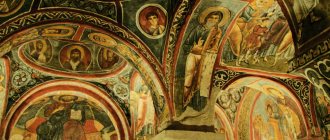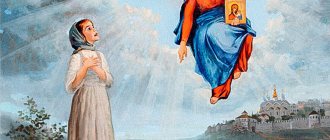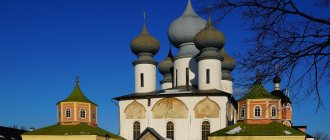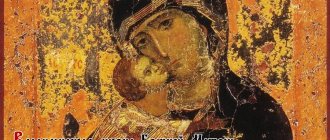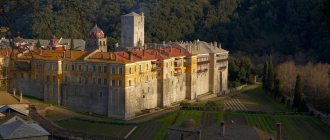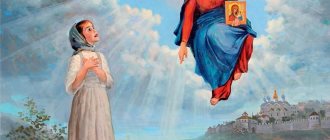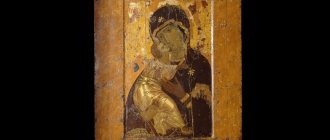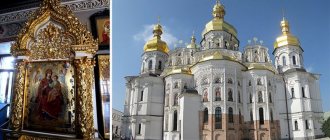The iconography of the Blessed Virgin is striking in its diversity. And this despite the existence of fairly strict canons, without compliance with which the image of the Mother of God will be considered just a painting, albeit on a theological theme!
The Icon of the Mother of God “Tenderness” is perhaps the most lively and reverent reflection of the Virgin Mary and Child. At one glance at her, you feel the depth of maternal and filial love, because despite the Divine essence, Jesus was once a baby and needed his mother’s affection.
The history of the acquisition of the icon, its types and description
The vast majority of Tenderness icons belong to the canonical iconographic type of Eleus (“merciful”). In the Greek tradition, this type is more often called Glykofilusa (“sweetly loving” or “sweetly kissing”).
Some researchers consider Eleusa to be a subspecies of another iconographic type of the Virgin Mary, Hodegetria. However, the Tenderness icon looks somewhat different and awakens different feelings in believers.
The Evangelist Luke himself is considered the discoverer of the Hodegetria type. He personally knew Mary and painted her face virtually from life. So the first images of this type appeared already two thousand years ago, at the dawn of our era!
Scientists believe that Eleusa separated from Hodegetria around the 9th-10th centuries. In any case, the first image of the Eleus type that has come down to us is a rock fresco in the Tokali Kilis temple (now in Turkey).
Images like Eleus - rock frescoes in the temple
In the 11th century, the Mother of God was increasingly painted in the type of Eleusa. Around the same time, the first Tenderness icons appeared in Rus' and gradually became the most beloved among icon painters. In fact, the appearance of Eleusa coincided with the birth of Russian Orthodoxy.
What does the image look like?
The icon depicts the Mother of God with a baby sitting on her lap. Mary is dressed in a traditional maforia with stars symbolizing her purity. The love-filled gaze of the Mother of God is usually focused on the Divine Son, but in some versions she looks at the person praying.
Baby Jesus here is just a child. He does not bless or hold the Gospel, but trustingly clings to his mother. The same type includes the “Leaping of the Baby” icons, in which Jesus strokes his mother’s cheek with his hand.
A feature of icons of this type is the complete absence of distance between the Mother of God and the Savior. They cling to each other, which symbolizes the boundless love and trust between them. However, the mother’s gaze already expresses some sorrow: she anticipates the trials prepared for her Divine son.
A classic of this iconographic type is the half-length image of the Ever-Virgin. However, there are shoulder-length and even life-size icons of Eleusa. And some icons, although called “Tenderness,” are not Eleus.
Let's get acquainted with the most famous Tenderness icons that have survived to our times.
Vladimirskaya
According to legend, the first icon of this type was painted by the Evangelist Luke. Some believers claim that the icon of the Vladimir Mother of God kept in Russia is the same image from Luke.
However, the results of the research convince us that the Vladimir Icon was painted around the 12th century, so it cannot possibly be by Luke. Nevertheless, the Mother of God of Vladimir is the most ancient image of this type that has come down to us, residing in Russia.
The Vladimir icon was brought to Rus' in 1131 straight from Constantinople as a gift to Prince Yuri Dolgoruky. Then his son, Andrei Bogolyubsky, transported the icon to Vladimir, where it received its name. In the 14th century, the image came to Moscow, from where it subsequently left only for a short time.
The Vladimir icon is considered the protector of Russia, and naturally: many miracles are associated with it, including the expulsion of invaders from Russian lands. For example, she took part in saving Moscow from the troops of Tamerlane, the Horde member Akhmat, the Crimean Makhmet-Girey, and so on.
The Icon of the Vladimir Mother of God became the prototype of many copies, some of which (Volokolamsk, Seliger, Oran and others) are revered as miraculous. A distinctive feature of these images is truly God’s tenderness - Christ’s miniature foot (“heel”) turned towards the viewer.
The wonderful image survived decades of godlessness and is now in the Church-Museum of St. Nicholas at the Tretyakov Gallery. The miraculous icon continues to protect Rus' and heal the suffering to this day.
The main distinguishing feature of the prototype is the presence of an image on the back. There is displayed the “prepared throne” and the instruments of the passions. This is a later image, presumably by Andrei Rublev.
Pskov-Pecherskaya
The Pskov-Pechersk Icon of the Mother of God is considered a copy from the Vladimir Icon. Perhaps this is so, but a fundamentally different, later school can be traced here. In principle, the plot of the prototype is completely preserved, down to the poses and facial expressions, but the painting style itself is much more realistic.
According to historical chronicles, the Pskov-Pechersk Icon was painted in 1521 by the monk Arseny Khitrosh. Almost immediately she was transferred to the Pskov-Pechersk monastery, where her miracles have been chronicled since 1524.
The main “specialization” of this image is the restoration of vision - a special book describes several cases of miraculous healing from blindness. However, cases of recovery from other ailments, such as paralysis, have also been recorded.
This image was prayed to during enemy invasions. Believers believe that it was the Pskov-Pechersk Mother of God who contributed to repelling the attacks of the troops of Stefan Batory and Napoleon Bonaparte.
Pskov-Pechersk Mother of God in the Pskov-Pechersk Lavra
The Pskov-Pechersk Lavra has long been a stronghold of Orthodoxy. It did not stop working not only during the years of Soviet power, but even during the Great Patriotic War, when it was practically destroyed by bombing. It is believed that the Mother of God covered this holy place with her protective cover.
Now the image of the work of monk Arseny is in the main chapel of the Assumption Church of the Pskov-Pechersk Lavra. And St. Michael’s Church received a list, which later became revered.
"Recovery of the Dead"
The image of “Seeking the Lost” became famous for its numerous miracles. Particularly eloquent are the cases when the Mother of God saved people who were on the threshold of death, and sometimes even those who crossed it.
The history of the icon begins with an incident that took place in the 17th century near the town of Bor, Kaluga province. The peasant Fedot Obukhov was returning home for Epiphany, but was caught in a strong blizzard. Fedot was already freezing, but half-forgotten he prayed to the Blessed Virgin and promised to create an icon of the Mother of God for the parish church in honor of his own salvation.
At this time, another peasant heard a voice from the street saying, “Take it.” He decided to find out what was wrong, went out into the yard and saw a sleigh, and in it, the dying Fedot. The peasant warmed up, recovered over time and was not slow in keeping his promise. This is how the Borovsk Icon of the Mother of God appeared, which quickly became famous as miraculous.
Several lists were immediately made from the wonderful image. Subsequently it turned out that they inherited the wonderful properties of the prototype. For example, an icon from the village of Malizhino vigilantly protected parishioners from cholera.
The wonderful story of another list, originally in private hands, is also striking. It was owned by a parishioner from Moscow. This man lost his wife, fell into poverty, and was left with marriageable daughters.
Fervent prayer to the icon helped the Christian get out of poverty and arrange the fate of his daughters. He considered this a miracle of God and took the miraculous image to the Church of the Resurrection of the Word, which is on the Assumption Vrazhek.
The miraculous image of the “Recovery of the Dead” suffered from vandalism by the occupiers during the Napoleonic War - it was literally split into several parts. However, it was lovingly restored and left in the Resurrection Church on the Assumption Vrazhek, where it remains to this day.
Serafimo-Diveevskaya
Before us is the favorite icon of Seraphim of Sarov. The Monk Seraphim singled out this image among similar ones and prayed to it tirelessly. Even if he left his cell somewhere, he carried this icon with him.
Seraphim of Sarov was revered as a miracle worker during his lifetime, and his favorite icon helped him in creating many miracles. Suffering people came to him from afar, Seraphim anointed them with oil from a lamp that burned in front of the image - and the sick were healed!
Seraphim died at a very old age, in front of his beloved icon, which he himself called “The Joy of All Joys” (later the icon was called “Seraphim’s Tenderness”). He bequeathed the image to the Diveyevo convent, which he patronized throughout his life.
Silver pendant “Icon of the Mother of God “Tenderness”” (go to the SUNLIGHT catalog)
After the revolution, the Seraphim-Diveevo Monastery was closed, the nuns were dispersed, and the miraculous image was taken away. He traveled a lot to churches, until, in the end, he ended up in the personal residence of the Patriarch of the Russian Orthodox Church. Now every year, on the day of the Praise of the Mother of God, the icon is taken to the Epiphany Church, so that everyone who suffers can ask for healing, quenching sorrows and strengthening faith.
The Seraphim-Diveyevo icon is not the classic Eleusa. She is, rather, a close relative of the Ostrobramskaya Mother of God from Vilnius, who is revered by both Catholics and Orthodox Christians. “Tenderness” in this case is not a reference to an iconographic type, but the personal name of the icon.
There is no image of the baby Jesus on the icon for a simple reason: he has not yet been born. The Ever-Virgin is depicted at the moment when she learned the Good News about the upcoming birth of the Savior.
Despite the fact that in the temple of the restored Seraphim-Diveyevo monastery there is a late copy of the “Seraphim Tenderness”, it is revered no less than the sacred prototype.
Lokotskaya
The Lokot myrrh-streaming icon “Tenderness” is eloquent evidence that miraculous images appear in our days. Moreover, they are not necessarily created by icon painters in compliance with all canons.
The Lokot icon is a reproduction of the image of “Seraphim’s Tenderness”, cut out from an expired calendar. Dentist Natalya Murashkina bought this calendar out of pity and piety, only to prevent the desecration of the shrine.
Natalya brought the calendar home, cut out the icon and hung it on the wall. Imagine her surprise when the icon began to bleed myrrh, and on its back a miraculous image of the Mother of God appeared!
Nowadays the Lokot icon is one of the main shrines of the Orthodox world. On some days, she not only streams myrrh herself, but also causes myrrh to stream in other images. A special frame was made for her so that the wonderful image could be seen from both sides.
Gold pendant “Vladimir Icon of the Mother of God” (go to SUNLIGHT catalogue)
The meaning of the “Tenderness” icon
The Icon of the Mother of God “Tenderness” is a symbol of ideal maternal love and protection. It signifies the infinitely deep feelings that members of the Holy Family experience for each other.
Mary is revered as a symbol of purity and the standard of man. She also acts as a defender of the Russian land and all Orthodox Christians. The Mother of God endlessly loves her son, so in her gaze one can read sorrow from the knowledge of his future fate and suffering. However, in the figures of Christ and Mary one can read love not only for each other, but for all of us.
We sin and thereby increase the suffering of Christ. The Mother of God knows this, but does not cease to pray to her son for mercy towards sinners. And we endlessly honor her for her mercy and intercession.
In Russia, the veneration of icons of the Mother of God is very developed. Hundreds of churches have been consecrated in their honor. Every church has at least one image of the Mother of God “Tenderness”. Dozens of icons of this type are revered as miraculous.
Novgorod and Smolensk icons
For about 700 years, residents of the city in northwestern Russia revered the Novgorod icon “Tenderness.” The shrine is famous for its miraculous power, which was experienced by those who prayed in front of it. He protected people from destruction, fires and wars, and gave those in need physical and mental healing.
The Icon of the Mother of God “Tenderness” of Smolensk, in turn, became famous for the protection of local residents: during the attack of Polish troops on the townspeople in the early 17th century. It depicts the Virgin Mary with her Son and has gained popularity since 1103.
How does an image help?
The image of the Most Holy Theotokos, All-Good and All-Merciful, listens to all those who pray. She tirelessly helps women and men, babies and old people, rich and poor. There were cases when even non-believers prayed to the icon and received what they asked for.
They pray to the icon for:
- healing and maintaining health,
- deliverance from sinful thoughts and addictions,
- sending down healthy offspring,
- guiding children on the right path,
- gaining material well-being,
- help in finding a job,
- bestowing happiness in marriage,
- reconciliation with loved ones,
- protection from enemies and misfortunes,
- consolation in sorrows,
- strengthening faith.
The most powerful prayers are not for yourself, but for other people. It is believed that Eleusa most favors women who pray for the birth, health and well-being of children, because she is the standard of maternal love.
Feast of the Tenderness Icon
The day of celebration is individual for each icon. Moreover, each image can have several general dates of veneration, and there are also local holidays for specific lists.
It is almost impossible to give a complete list of memorable dates, so we will dwell only on the holidays of the most revered images:
- Vladimirskaya - June 3, July 6, September 8;
- Pskov-Pecherskaya - all holidays of the Vladimir Icon plus October 20 and June 5 (transitionable);
- “Recovery of the Dead” – February 18;
- Serafimo-Diveevskaya - August 1 and August 10;
- Lokotskaya - so far like the Seraphim-Diveevsky image.
Where is the icon of the Tenderness of the Blessed Virgin Mary located?
The shrine of the Mother of God can be found in Golitsyno in the Cathedral of Seraphim of Sarov. In the last century, somewhere in the 60s, from the Seraphim-Diveevo Monastery, one of the nuns handed over the miraculous copy of the cell image of the Most Holy Theotokos Seraphim of Sarov for safekeeping to the icon painter Alexei Artsybushev.
This miraculous icon of Tenderness, which was painted in the 19th century, was in the artist’s house for over 40 years, but after that he donated the shrine to the Cathedral of St. Seraphim of Sarov (Golitsyno) that was under construction.
One of the most revered copies of the divine image is in the Trinity Cathedral of the Seraphim-Diveyevo Church, in whose honor the border was even consecrated. The face was painted somewhere in the late 19th - early 20th centuries by the nuns of the monastery. Although the image exists relatively recently, during this time it has become widely known due to its miraculous properties.
The best article for you, go to: Saint Paphnutius Borovsky
In honor of this face, special days of veneration were even determined, which fell on December 9 and July 28, and before the start of the service, every week on Sunday the Paraklis church chant is held in front of the divine image.
The most revered shrine among the Orthodox people is located in the capital in the Patriarchal Epiphany Cathedral.
How to pray to an icon correctly
For each revered icon of the Mother of God, akathists, troparia and kontakia were compiled. And the more famous and revered the image, the more of them there are.
There are dozens of canonical prayers addressed to various Tenderness icons. But we must remember that we are not turning to the image, which is a conductor between the earthly and spiritual world, but to the Blessed Virgin herself. Therefore, you can read any prayer to the Mother of God, regardless of her icon, and be heard.
Prayer text
To whom shall I cry, Lady? To whom shall I turn in my grief, if not to You, Queen of Heaven? Who will accept my cry and my sighing, if not You, Most Immaculate, Hope of Christians and Refuge for us sinners? Who will protect you more in adversity? Hear now my groaning, and incline Your ear to me, the Lady of the Mother of my God, and do not despise me, who requires Your help, and do not reject me, a sinner. Give understanding and teach me, O Queen of Heaven; do not depart from me, Thy servant, O Lady, for my murmuring, but be my Mother and Intercessor. I entrust myself to Your merciful protection: lead me, a sinner, to a quiet and serene life, so that I may weep for my sins. To whom shall I turn when I am guilty, if not to You, the hope and refuge of sinners, with the hope of Your ineffable mercy and Your bounty? Oh, Lady Queen of Heaven! You are my hope and refuge, protection and intercession and help. Best regards to my queen and speedy intercessor! Cover my sins with Your intercession, protect me from enemies visible and invisible, soften the hearts of evil people who rebel against me. Oh, Mother of the Lord my Creator! You are the root of virginity and the unfading flower of purity. Oh, Mother of God! Give me help to those who are weak with carnal passions and those who are sick at heart: for it is Thine alone, and with You Thy Son and our God interceded for us, and by Thy wonderful intercession let the hut I will be delivered from all misfortune and adversity, O most immaculate and glorious Mother of God, Mary. Moreover, with hope I say and cry: Rejoice, O Blessed One, Rejoice, O O Joyful One, Rejoice, O Most Blessed One, the Lord is with Thee.
Here is the text of one of the petitionary prayers to the Mother of God, but there are also thanksgiving and repentance prayers, as well as prayers to specific images. All canonical texts were written by famous theologians, including those who have been canonized.
However, if the canonical texts seem complex and incomprehensible to you, pray in your own words. The All-Good Mother of God hears all prayers addressed to her, especially if our thoughts are sincere and pure!
21.10.21
Prayers before the icon “Tenderness” Seraphimo-Diveevskaya
If you pray correctly in front of the Tenderness icon, help will definitely come. First of all, it is necessary to give power to words so that they return to the double dimension. They ask in the sanctuary for freedom from suffering and mental pain, ease of childbirth, harmony, but despite the differences in these requests, they need one thing: sincerity, purity of what they want. Therefore, having gained warmth to receive the support of the Most Holy Theotokos, you need to say the following prayer:
Troparion, tone 4
To the Mother of God with tenderness, let us fall, / all, gravel of obsession, / the miraculous icon of Tenderness, kissing / and crying with tears: / Lord, welcome the prayers of the unworthy.
Translation: All those burdened with sins will turn to the Mother of God with sincere repentance, kissing her miraculous icon of tenderness and crying with tears: “Lady, accept the prayer of Your unworthy servants and grant great mercy to those who ask.”
Kontakion, tone 3
Yuzhe, imitating the good fig, / I, damned, do not bear the fruit of tenderness, and I am afraid, / but, looking at the miraculous icon of Your tenderness, Lord, I rejoice, / I am grateful, /// the grace to give spiritual affection and sincerity.
Translation: Imitating the barren fig tree (Luke 13:6-9), I, the accursed one, do not bear the fruit of humility at all and am afraid of being beheaded, but looking at the miraculous icon of your tenderness, Lady, I sigh from the bottom of my heart and cry: “Have mercy, O Merciful One, and I, petrified in my heart, do good and bestow spiritual and sincere humility.”
First prayer
O Most Holy Master, Mother of God, I must! Accept our unworthy prayers, save us from the suggestions of evil people and desperate death, give us repentance to the end, so that our prayers are merciful and joyful, grant me in sad pain. And save us, Lady Theotokos, from all troubles, misfortunes, pain, illness and all evil, and grant us, your sinful workers, who have a reason to become eternal life with all the saints forever in the second coming of the coming of the Son of Christ. Amen.
Second prayer
Accept, O merciful, Most Holy Lady, Lord Theotokos, these honorable gifts that are only given to You, by us Your unworthy deeds have been bestowed: from all generations chosen by You, the most powerful of all heavenly gods... and the earthly Son of God, who knows and accepts His holy Body and His Most Holy Blood; blessed also by the birth of generations, blessed by God, the brightest and most honest Cherubim Seraphim. And now, Most Holy Theotokos, do not cease to pray for us, your unworthy servants, spare us all the advice of the evil one and this whole situation, and remain unharmed for all of us; but to the end, for your prayers not condemned, watch over us, for by your intercession and help we save, I give glory, praise, thanksgiving and admiration to all in the Trinity, the one God and Creator of all. Amen.
Prayer three
Oh, Most Holy Virgin Mother of God, Christ the King and God of our Mother, Treasure of tenderness and Source of Mercy, gifts of the soul giving to the Giver and to sorrowing souls, the Blessed Comforter! We fall to You with love and before Your holy icon we humbly pray: pray, Master, Your beloved Son, Christ our God, to have mercy and save us who are perishing in sin; breathes into our souls our sincere repentance and divine tenderness, sheds cleansing tears during prayers; Favorable life, temporary and eternal salvation, mercifully, O Lady, grant us; the dying world, the holy temple, which [or the holy abode of this very good] safe, serene and abundant fruits of the earth, we have sent down, and at the death of our life Maternyago does not deprive us of your intercession and your help, but the intercession of Your Praise comfortably experience the air and be worthy of the Kingdom of Heaven... To her, Good Queen, all the joys of Joy and the whole world of Christian consolation! Help us now, and when your holy help is most important, we demand and save us with your maternal prayers to Christ God, Him with the Father and the Holy Spirit. Amen.
